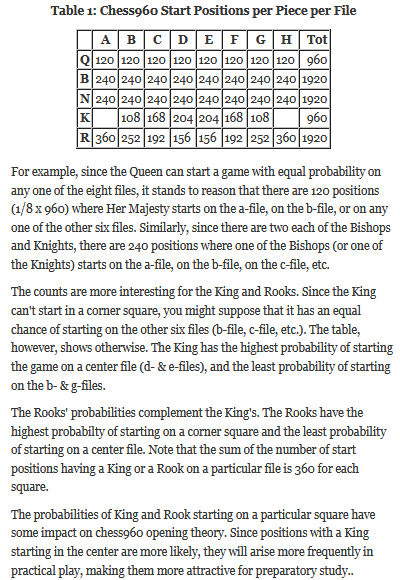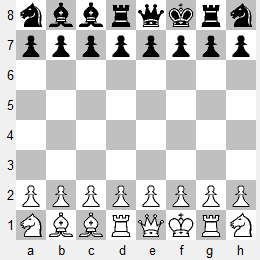Another general rule is that castling considerations are more complicated in chess960 than in traditional chess, even if specific start positions might be less complicated.
It turns out that the observation also applies to the rules for castling. The 'Purported Problem' post was based on hundreds of comments to a Chessbase article, of which the last half might be called the Petrarlsen - Celeje debate. For more than a month the two parties discussed the pros and cons of various castling rules, all of them alternatives to Fischer's chess960 rules. I won't enter into that debate -- this is a chess960 blog -- but there were a number of thought-provoking points that are worth discussing. For example:-
In certain [chess960] positions, the [castling] King moves toward the center.
A little thought is enough to determine that these are positions where the King starts on the b-file and castles O-O-O. This brought me once again to an old post on my main blog, Introduction to Chess960 Geometry (March 2009), where I developed the following table. Pardon me for taking a snapshot of the table and its discussion, which is easier than copying everything separately.

From that table we learn that there are exactly 108 positions where the Kings start on the b-file. When one of those Kings castles O-O-O, it starts on the b-file and ends on the c-file. While that might be a (small) disadvantage, it is counter-balanced by the simultaneous activation of the Rook that started on the a-file. Since all start positions with a King on the b-file imply a Rook on the a-file, there is another important consideration for the opening plan: How to activate that Rook? There are four ways to do this:-
- Castle O-O-O [moving the King toward the center]
- Castle O-O [switching the King from the b- to the g-file]
- Moving the King to the second rank
- Moving the Rook along the a-file
The strategy that a player chooses -- remember that both White and Black have the same options -- depends on the overall strategy for developing all eight pieces. Each one of those four choices for King/Rook activation has an impact on the choices for the other six pieces and vice versa.
That last observation might seem obvious, but a second observation might be less obvious. Of the six files where a King can start the game, the simultaneous considerations for castling (King safety and Rook activation) present six different scenarios. For example, in those positions where a King starts on the d-/e-files, the choice of moving the King to the second rank is less attractive than when the King starts on the b-file. On the d-/e-files, the King is more exposed to attack than on the b-file, and moving to the second rank doesn't really change this.
The special considerations for castling arise because a single move alters the position of two pieces of the same color. In the Petrarlsen - Celeje debate, Petrarlsen (a chess960 antagonist) argued that the chess960 castling rules must respect the exact same goals of King safety and Rook activation found in the traditional setup (SP518 RNBQKBNR). Celeje (a chess960 protagonist) was more flexible. What would Petrarlsen say about the start positions When Castling Undevelops a Rook (September 2010)?
It's curious that even in SP518, the consequences of castling to the two sides are not completely equivalent. Castling O-O-O moves the King one square off-center and develops the Rook to the center. Castling O-O moves the King closer to the corner, but doesn't bring the Rook to the center. Both scenarios often require a second move to correct the deficiency of the castling move. Castling O-O-O is often followed by Kc1-b1, while castling O-O is usually followed by a further Rook move.
Similar considerations apply to all of the other 959 start positions. If we want all chess960 positions to mimic the traditional position, we might as well just play only that position.

